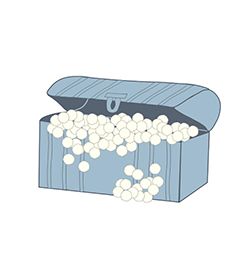When Interest Rates Rise, What Happens to Bonds?
 When the Fed raises the federal funds target rate, bond market values will decline, and the longest term bonds will suffer most. But that’s only part of the story - as interest rates increase, new bonds offer higher returns to stay competitive.1
When the Fed raises the federal funds target rate, bond market values will decline, and the longest term bonds will suffer most. But that’s only part of the story - as interest rates increase, new bonds offer higher returns to stay competitive.1
Quality bonds have a place in a portfolio, but many investors direct their money elsewhere as interest rates increase. Consequently, when the Federal Reserve raises interest rates, bonds tend to lose market value. So, assuming the economy stays healthy and appetite for risk stays strong, what role do bonds and bond funds play in a portfolio when rates begin to climb?
The impact of rising rates can vary.
Interest rates are one of the leading factors in bond prices, but short-term bonds, long-term bonds, and bond funds respond differently to fluctuations in interest rates. Coupon rates on short-term bonds have tracked closely with the effective federal funds rate over the past 30 years. Long-term bond coupon rates more loosely follow the fed funds rate, trending in the same direction with similar cycle peaks.2,3
Long-term bond prices tend to be hit harder by higher interest rates. They may lose market value, but eventually the higher coupon rates will result in extra income for the patient investor.4
Bond funds invest in many different types of bonds, and this diversity tends to provide a better shield against rising interest rates than single bonds can offer. Bond funds are safer investments for portfolios that aren’t large enough to spread the risk across many different individual bond types. Funds can also lower the risk of default and the risk of callable bonds being repurchased by the borrower before maturity.5
In a rising interest rate environment, bond fund investors can see their share prices decline until rates level off or dip again. However, a diversified bond fund will reinvest interest payments into new bonds with higher coupons, which will yield increased returns over time.6
Historically, certain bonds have delivered returns even through periods of rising rates. From 1975 through 2021, our economy witnessed six rising interest rate environments. They lasted from two to five years with T-bill rates increasing between 2.3-11.9%. In those six instances, the total annual return for Barclays U.S. Aggregate Bond Index (the S&P 500 of the bond market, representing a diverse mix of high-quality intermediate-term bonds) ranged from 2.6-11.9%, with most of the total annual returns at between 4-6%.7
In a rising interest rate environment, bond fund investors see principal values decline until rates level off or dip again. A diversified bond fund will reinvest interest payments into new bonds with higher coupons, which means investors will see increased returns with time. 3
Long-term bonds tend to be hit harder by higher rates. They may lose market value, but eventually the higher rates will result in extra income for the patient investor. A bond portfolio’s average duration is a measure of its sensitivity to the movement of interest rates. It factors in premiums or discounts when bonds are purchased and is expressed as a number of years. The higher the duration, the more volatile the bond fund will be as interest rates move up or down, and the longer it will take for a downward price cycle to reverse as bonds mature at face value and are replaced by higher-yielding bonds.1,3
Playing It Safe
A mix of bond terms can be the best way to hedge against fluctuations in interest rates. Investors who conduct their own research and have enough funds to purchase a diverse array of bonds can compile their own mix of this asset class to round out the fixed income portion of their portfolio. Bond laddering can give investors the flexibility to make adjustments in their portfolios through reinvested funds over time, while allowing them to realize the full yield of matured bonds.8
Bond investors may take advantage of short-term or mid-term bonds’ increased turnover with laddered maturity dates, accepting lower interest rates compared to the longer term maturity bonds in exchange for a potentially smaller drop in the market value if rates rise. Investors after higher rates of return from short-duration bonds may have to look to investment-grade bonds, but without AAA or AA ratings. If interest rates rise sooner rather than later, exploiting short maturities could return principal back in the short term, providing cash for reinvestment as interest rates go up. If bond owners expect pain in the coming years, they can limit themselves to small positions in government bonds, investment-grade corporate bonds, and bond funds with durations of 10 years or less. 6
Treasury Inflation-Protected Securities (TIPS) pay interest twice a year at a fixed rate. However, that rate is applied to a principal which is adjusted based on fluctuations in the Consumer Price Index (CPI). These securities offer good protection for investors in a high-inflation environment when the CPI is rising, as the amount they pay out in interest will rise during those times. TIPS interest payments will decrease when inflation falls.6
Holding onto your investment longer can lower your market risk. Periods of rising interest rates give way to periods of declining interest rates, and your timing can significantly affect your returns. A recent rule of thumb maintains that returns from well-managed bond funds will overcome decreases in share price if the investor hangs onto their shares for at least double the duration minus one year. 9
Duration does not represent any actual span of time; rather, it is a mathematical estimate of how sensitive a bond or bond fund’s price is to the movement of interest rates. Duration is calculated from a variety of factors that influence bond price, and the result is meant to approximate how many years it would take to recoup your investment if interest rates change by 1%.10
Taking a Long-Term View
Bonds still belong in a balanced portfolio, particularly one which is being used to supply income. In bull markets, putting money into an investment returning 1.5% for 10 years may seem overly cautious. However, it can make more sense when viewed in the context of portfolio diversification and the need for consistent returns.Keep in mind that fluctuations in interest rates and premiums will not affect holders of non-callable bonds who hang onto their bonds until maturity and collect the guaranteed proceeds.4 Holders of bond fund shares can also look forward to income while they wait for share values to increase with the next downward trend in interest rates.6
Market participation comes with trade-offs: if interest rates rise significantly over several consecutive years, owners of long-term bonds might find themselves losing out in terms of their portfolio’s potential. On the other hand, bonds have never lost half their value; stocks have.
Citations.
1 - thebalance.com/why-do-bond-prices-go-down-when-interest-rates-rise-2388565
2 - stlouisfed.org/on-the-economy/2017/october/increases-fed-funds-rate-impact-other-interest-rates
3 - schwabassetmanagement.com/insights/content/8-questions-on-bond-market-and-rate-hikes
4 - investopedia.com/articles/investing/101515/effect-fed-fund-rate-hikes-your-bond-portfolio.asp
5 - fidelity.com/learning-center/investment-products/mutual-funds/bond-vs-bond-funds
6 - marketwatch.com/story/heres-how-you-can-play-it-safe-with-your-investments-as-interest-rates-rise-11649350072?mod=bonds
7 - marketwatch.com/story/how-your-bond-portfolio-can-survive-higher-rates-2015-04-23
8 - tickertape.tdameritrade.com/investing/changing-interest-rates-long-term-investors-15829
9 - morningstar.com/news/marketwatch/20211023251/you-can-beat-your-fear-of-losing-money-with-bonds-as-interest-rates-rise-if-you-understand-this-one-thing
10 - finance.zacks.com/bond-sensitivity-interest-rates-3320.html








